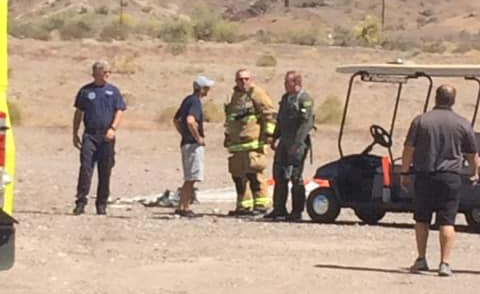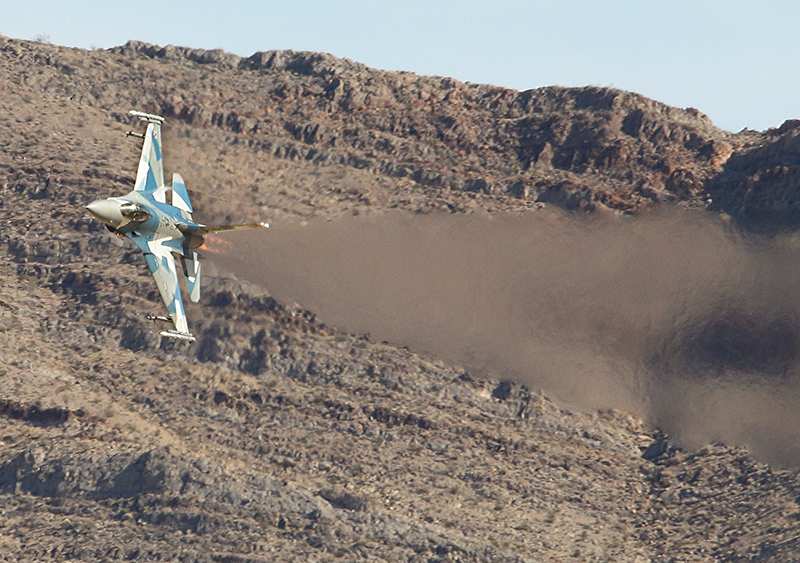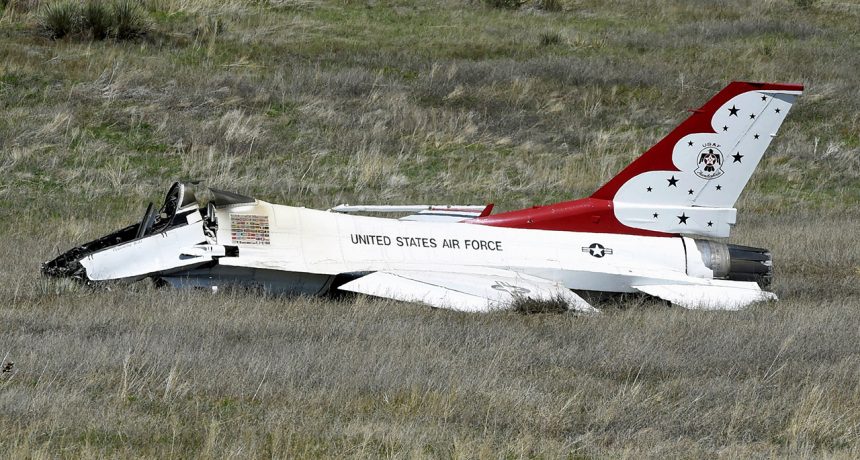The Luke AFB F-16 Emergency Landing, the Tragic Thunderbird Crash, The CH-53 Accident: Why (Does It Seem Like) So Many Military Aircraft Are Crashing?
Why does it seem like so many military aircraft been crashing? It’s a relevant question given the attention to military aircraft accidents around the world this year. Is there an increase in accidents in military aviation? Or, are other factors influencing our perception of how many aircraft accidents there actually are?
Pilots and aviation safety experts will tell you there is no singular cause for all military aviation accidents. In an April 25, 2018 interview in the Washington Examiner, Capt. Sarah Burns, a Marine Corps spokeswoman at the Pentagon told reporter Jamie McIntyre, “Every mishap is unique, and we have not found a causal, statically accurate link between readiness and mishaps.”
While pilot shortages and aging aircraft dominate the conversation in the U.S., pilots often say there are as many reasons for accidents as there are accidents. If you demand a singular explanation for why aviation accidents happen it’s in this famous, often paraphrased quote attributed to Captain A. G. Lamplugh, British Aviation Insurance Group, London, from the early 1930’s:
“Aviation in itself is not inherently dangerous. But to an even greater degree than the sea, it is terribly unforgiving of any carelessness, incapacity or neglect.”
Capt. Lamplugh’s prescient quote summarizes three separate contributors to aviation accidents: carelessness, often sanitized as “pilot error”; incapacity, in air traffic control, pilot training and other technical contributors; and finally neglect, as in infrastructure and maintenance.
In the rush-to-judgement popular news and social media space, pundits try to focus on a single convenient narrative to explain accidents. There is no convenient single reason for military aviation accidents.
One factor that has contributed to an increase in awareness of military aviation accidents is an evolution in media. Our perception of how many accidents there are has no doubt been influenced by a factor we can refer to as “media velocity”, the speed and volume at which information reaches us in the social media age.

After a U.S. Air Force F-16 performed an emergency landing this week in Arizona and the pilot ejected, the full details of the incident were posted on social media, including intercepted radio transmissions of first responders, with two hours. Detailed information about the incident was available through social media and blogs hours before less detailed, official information was released. In the case of this week’s F-16 accident, the sources and information have so far proved to be accurate. That is not always the case, and the online banter about causes for aviation accidents seldom waits for the official investigation to reveal its findings.

With international crashes, such as the March 6, 2018 crash of a Russian Antonov An-26 with 39 fatalities in Syria, there used to be reduced awareness of military aviation accidents prior to the fall of the Iron Curtain and the arrival of social media. Every country lost military aircraft, but not every country reported losses with the transparency of the United States.
When pundits point to a single factor in a perceived increase in aviation accidents in the U.S. the pilot shortage inevitably comes up. While it is a mistake to make an “A leads to B” connection between pilot shortages and aircraft accidents, there is no denying the U.S. military pilot shortage is real.
We spoke to a U.S. Air Force Lt. Col. whose call sign is “Burn Clapper” at Holloman AFB in August, 2017. He had been in command of the 54th Fighter Group since May, 2017. During a media briefing he told TheAviationist.com, “I’m supposed to have 24 instructor pilots in my squadron, and I have 13 now.”
When we asked Burn Clapper about the reasons for the fighter pilot shortage he said, “A few years back, there was a time when we had as many fighter pilots as we needed. We only produced guys coming in for as many guys who were leaving – at the rate that they were leaving then. We only made fighter pilots for who was leaving then, maybe about 400 a year – that’s a guess.”
Burn Clapper went on to explain, “Our pilots graduate now with a 10-year commitment. They have been back and forth to combat over the last five years. The economy is good now. Now they have options.”
The U.S. Air Force publishes a database of aircraft accidents. The Air Force Safety Center Aviation Statistics database (http://www.safety.af.mil) contains specific information detailing USAF accidents. As with any spreadsheet analysis, you can package the data in different ways to produce a different statistical outcome.
One interpretation of the Air Force Safety Center Aviation Statistics database is that 2015 had a higher number of reported accidents than 2016 and 2017.
Another standout metric is the number of accidents in the single engine F-16. The statistics for Current Fiscal Year-to-Date, Previous Fiscal Year-to-Date and Previous Fiscal Year show a total number of F-16 Class A accidents higher than any other aircraft type. There are several contributing factors to F-16 accidents that include the large number of the aircraft in service with the USAF (951 F-16s in USAF service across all versions according to Wikipedia), its role as a high performance tactical combat aircraft, the age of the aircraft and that the F-16 is a single engine aircraft with no engine redundancy. By contrast however, the single engine, exclusively single-seat F-35A Lighting II has not had a single accident in flight with the USAF since its initial inclusion with the Air Force on August 2, 2016. The F-35 Joint Strike Fighter as a program has had a remarkably incident-free development, testing and operational introduction since it began, budget concerns aside, there has not been a single crash of an F-35.
A contrasting view of military aviation accident statistics was presented by the Military Times in an April 8, 2018 analysis by journalist Tara Copp.
Copp wrote that, “Through a six-month investigation, the Military Times found that accidents involving all of the military’s manned fighter, bomber, helicopter and cargo warplanes rose nearly 40 percent from fiscal years 2013 to 2017. It’s doubled for some aircraft, like the Navy and Marine Corps’ F/A-18 Hornets and Super Hornets. At least 133 service members were killed in those fiscal year 2013-2017 mishaps, according to data obtained by Military Times.”
Military Times journalist Tara Copp arrives at an interesting conclusion in her article when it is overlaid with the USAF Safety Center Aviation Statistics database. Copp revealed that accidents with the U.S. Navy and Marine Corps’ F/A-18 Hornets were much higher than with other aircraft in Navy and Marine service. This finding aligns with the statistical survey of USAF F-16s emerging as the highest frequency accident types. Similar factors exist with the Navy and Marine F/A-18s.
The last of the older Hornets are being phased out now in favor of the newer F/A-18E/F Super Hornets. The aircraft is mostly a single-seat combat plane often flown at low altitude and in the high-performance regime. Unlike the Air Force’s F-16 though, the F/A-18 is a twin-engine aircraft, making engine failures a less critical incident over the entire performance envelope compared to the single-engine F-16, where any engine failure is serious.
Journalists like Tara Copp have pointed to several factors in their reported increase in military aviation accident frequency. Copp wrote that, “The rise is tied, in part, to the massive congressional budget cuts of 2013. Since then, it’s been intensified by non-stop deployments of warplanes and their crews, an exodus of maintenance personnel and deep cuts to pilots’ flight-training hours.” She went on to quote retired USAF General Herbert “Hawk” Carlisle as telling her, “We are reaping the benefits — or the tragedies — that we got into back in sequestration.” Retired General Hawk was referring to the 2013 defense budget cuts resulting from the U.S. government sequester, a temporary freeze on much of U.S. government spending to avert a monetary crisis. Tara Copp went on quote Ret. Gen. Herbert Carlisle as saying “The sharp increase in mishap rates is actually a lagging indicator. By the time you’re having accidents, and the accident rates are increasing, then you’ve already gone down a path.” Then-General Carlisle led USAF Air Combat Command until 2017. The retired general told her, “If we stay on the current track … there is the potential to lose lives.”

No matter which narrative you chose to explain recent military aviation accidents one truth does prevail about flying high performance aircraft that are intended for combat; tragedies are an ominous and common companion to aerial warfare, and recent events have been a stern reminder of this truth.









